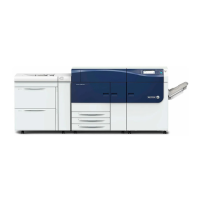Suggested SolutionsProblem
• Perform Initial Actions.
• Acquire your measuring tool from the Nationalization Kit
and check the frequency of the spot intervals:
• If the defect occurs every 44 mm on the prints, do not
replace the drum. This interval is caused by a damaged
or defective Developer Housing.
• If spots or bands occur every 147 mm on the prints, the
Yellow, Magenta, Black or Cyan Drum is damaged or light-
shocked. Run your Halftone Test Pattern to determine
which color drum is affected. Replace or swap the appro-
priate Drum cartridge (Replacing a Drum Cartridge).
• If the defect occurs every 374 mm on the prints, replace
the Fuser Belt Assembly (Removing the Fuser Module).
Spots at equal intervals
• Perform Initial Actions.
• Check for Drum failure. Acquire your measuring tool from
the Nationalization Kit . Run the Halftone Test Pattern
to determine which color drum is affected. Replace or
swap the affected color Drum cartridge (Replacing a Drum
Cartridge).
• Perform the Cleaning the ROS Windows procedure.
Solid color streaks (lead edge to
trail edge)
If you run multiple width papers, refer to Tips for Extending
Fuser Life and Preventing Fuser Damage for more informa-
tion.
Edgewear
• Perform Initial Actions.
• From the Stock Library Manager on the print server, access
the Advanced Stock Setup screen and adjust the Second-
ary Transfer Voltage Adjustment.
Halo or smudges
Unfused dry ink / toner collected on the ROS windows located
above the Drum Cartridge Drawer prevents the image for
that color to be captured. Streaks will display on the output
if the ROS windows are contaminated. Perform the Cleaning
the ROS Windows procedure. Use the provided wand to re-
move dry ink / toner that has collected on the ROS window.
White streaks or deletions
Xerox
®
Versant
®
2100 Press10-10
User Guide
Problem Solving

